first published in Juxtapoz, August 14, 2019
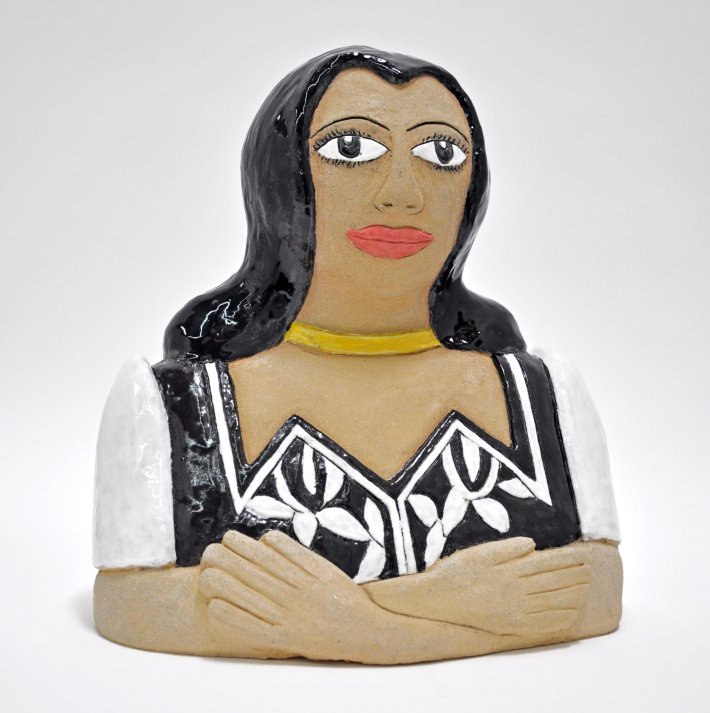
Back to Back: Maryam Yousif & Nick Makanna @ Guerrero Gallery
By Tamsin Smith & Matt Gonzalez
————————
Maryam Yousif: Puabi Live! / July 20 – August 17, 2019
& Nick Makanna: Spiral Architect / June 14th – July 13th, 2019
Guerrero Gallery, 1465 Custer Avenue, San Francisco
————————
Maryam Yousif and Nick Makanna are part of an exciting resurgence in ceramic art occuring in the San Francisco Bay Area. In back-to-back shows at Guerrero Gallery, the married couple separately demonstrate how clay has a resonance as primordial as it is universal.
The Quran and the Bible both contain references to clay being the substance from which humankind was originally created. In Greek mythology, Prometheus molded men out of water and earth. Long before Islam or Christianity or Hesiod, the Sumarian epic of Gilgamesh formed a wild man made of clay, whose friendship taught the tyranical King humanity. Science too connects clay and the human body through its shared elemental constituents: iron, calcium, oxygen, sodium, potassium, magnesium, hydrogen, carbon, nitrogen, etc.
Most people, when they harken back to grade school, can recall the joy of molding clay. It’s an early, tangible encounter with imagination; a first taste of how it feels to shape the world in our own image. Curious then, that relatively few contemporary artists have managed to turn this medium of expression into an accepted fine art practice. One exception, of course, is the funk movement, which emerged in the Bay Area in the last century, as a reaction to and expansion beyond abstract expressionism. At its best, visceral, sensuous, idiosyncratic shapes and figures emerge from a purity of unabashed, playful, and unconstrained feeling. As such, the clay becomes an act of 3-dimensional liberation.
A funk-infused enactment of breaking through pervades Bagdad-born Maryam Yousif ceramic sculpture in “Puabi Live”. Yousif’s solo presentation of glazed stoneware and porcelain at Guerrero Gallery in San Francisco imagines the modern incarnation of Mesapotamian Queen Puabi, whose lush life entails fantastical objects of adornment and adoration. Yousif, who received an MFA from the San Francisco Art Institute in 2017, draws us into Puabi’s high-life world, beckoning viewers to keep up with the ancient city of Ur’s precursor to Kim Kardashian and Princess Diana.
Maryam Yousif, “Warda Tape” & “Majida El Roumi Tape”.
In the main gallery space, a low pedestal “tarp” has been laid out with an assortment of objects referencing an active archeological site, in which found artifacts are carefully placed as if awaiting examination. Vases, a bird bath, strewn bead necklaces, stage props, crowns, punch bowls, artificial party flowers, and a large bust of Puabi, form a trove of treasures in which ancient shapes are updated with pop colors and embellished with “selfies”.
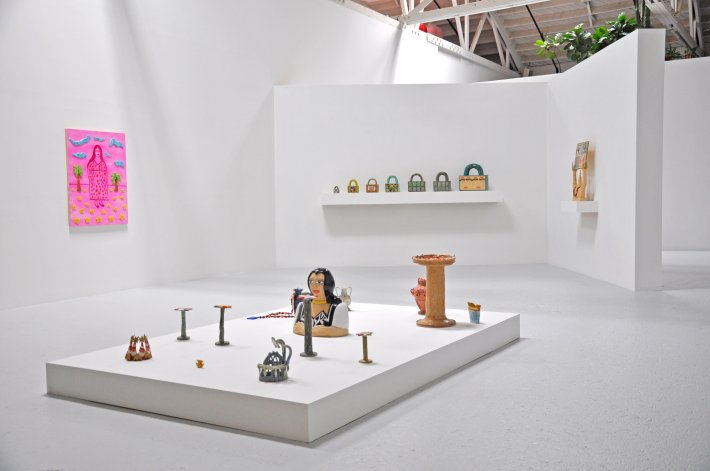
Installation view, “Puabi Live!”, Guerrero Gallery, 2019.
Stone tablets affixed to the gallery walls, of the kind one imagines Moses might have carried down from the temple, also command attention, allowing us to examine Queen Puabi’s own collection of contemporary Arabic music cassette tapes. The impression of Puabi as a bit of a style maven is reinforced with a peak into her closet with a shelf full of handbags that feature designs (stars, scroll, concert poster, and queenly eyes) that recur in and reference other pieces.

Puabi Palms Pot (large), glazed 20 x 5.5 x 19.5 inches, 2019.
Amid the charm and beauty of Yousif’s impressive constellation of fresh delights is the rub of recent history. The work is exuberant, infectious, and classic, with a twist of the swinging ‘70s, when the port town of Bassra was known as the Venice of the Middle East and Baghdad’s book stalls and broad boulevards bustled with vitality. Most Americans don’t know this Iraq. We know the country of Yousif’s birth through grainy CNN images, presented as virtually indistinguishable from other countries in the region with which the United States remains at war.
Both her lyrical execution and creative choices commend Yousif as an artist. As the viewer comes to see her colluding with Puabi — perhaps even as an alter ego — it is deeply affecting to welcome the notion of a dynamic, free-spirited woman in modern-day Iraq, able to rule her own life and showing the rest of us how it’s done.
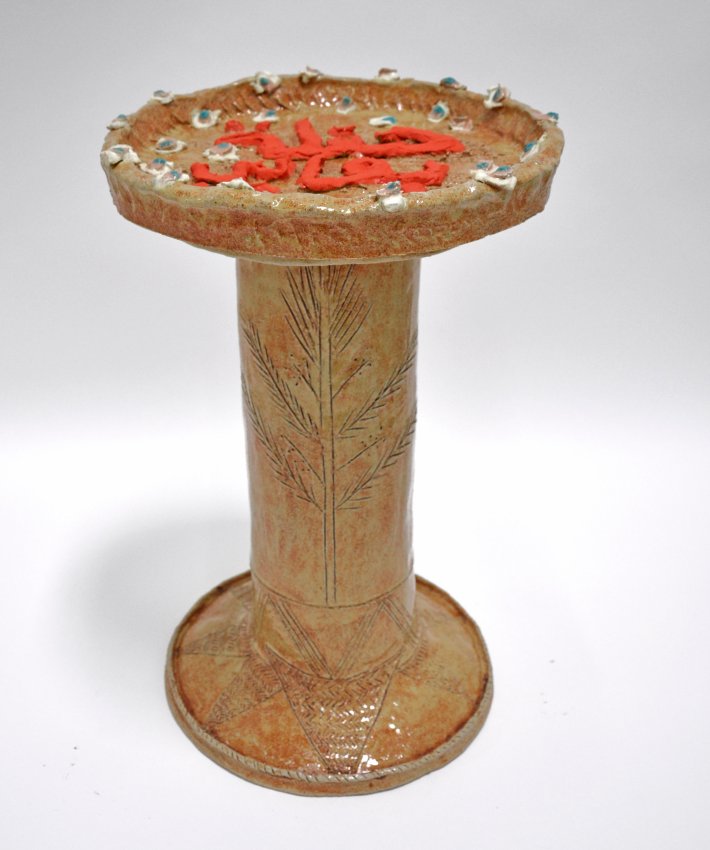
Maryam Yousif, “Party Bird Bath”, glazed stoneware, 14 x 14 x 21.5 inches, 2019.
Partially overlapping with the Guerrero show, in June 28-July 27, 2019, Yousif exhibited similarly themed work referencing mythical and historical figures, as part of a three-person show “Summer Sessions: Part I: The Lands Beyond”, at Anglim Gilbert Gallery in San Francisco.
Nick Makanna returns to Guerrero Gallery after his 2017 exhibition “Dust” presenting work at variance with Yousif’s method. Where she relies on recognizable objects for storytelling, Makanna offers ambiguity which allows for contrasting interpretations.
Twisting segmented columns and connected meandering circular forms comprise key elements of Makanna’s architectural ceramic works. Lead-glazed in an array of bright colors, the pieces express a non-objective playfulness and whimsy. The gallery statement suggest the show is about “the excesses of empire and decaying infrastructure”, but the works, which are mostly fired with a glassy and somewhat opaque colored glaze, have an optimism that brightens the gallery space and belie that description. Only in so far as the pieces are spindly, open-space forms, do they suggest fragmentation, and thus decomposition.
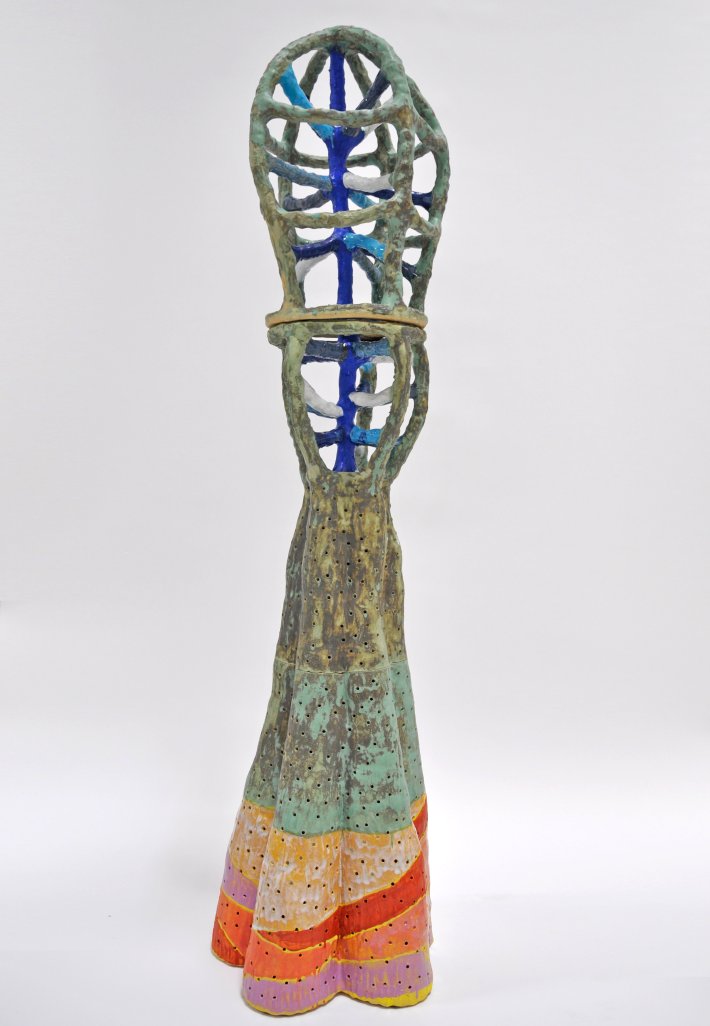
Nick Makanna, Rune XXXI, glazed ceramic, 69 x 16 x 16 inches, 2019.
Lanky yet spacious, and reminiscent of architectural support, Makanna’s sculptures present as construction frameworks. Through their lack of density, these pieces unlock competing possibilities because they contain space without insisting upon absolutes. Their airy openness speaks to the interconnectedness we all thrive on. One can see these as clay versions of a cluster of wires sending communications in every direction. This is akin to the web-like way a human body has nerves and veins travelling throughout its encasement. These compelling ceramics can be read as skeletal frameworks, part of an urban scaffolding, not unlike a rib cage that protects the body from harm.
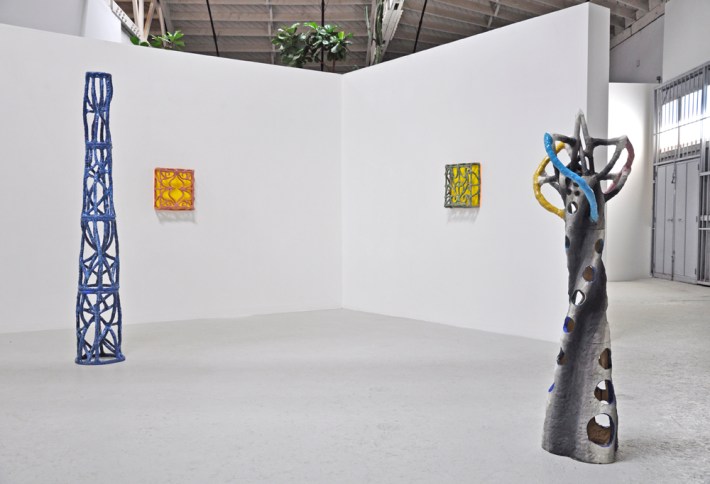
Installation view, “Spiral Architect”, Guerrero Gallery, 2019.
It can be said that Makanna, who received an MFA from the San Francisco Art Institute in 2016, is drawing with clay in variegated colors. The human hand is apparent, both in the way slight finger impressions in the clay survive the firing process, but also in the lack of perfectly straight forms. The primary lines of the completed structures are wavy, just like a human drawing is, showing the artist process.

Nick Makanna, Rune XXXIII, glazed ceramic, 86 x 16 x 16 inches, 2019.
Architecturally speaking, the progenitor for Makanna’s openwork spires are Simon Rodia’s Watts Towers, completed in the early 50s after three decades of work. Now part of the canon of outsider art, Rodia made his towers out of steel rebar, wrapped with wire mesh, and a layer of cement mortar mixed with found shards of mirror, bottles, and anything he could get his hands on. The tallest stands nearly 100 feet high.
In Rodia’s case, the openwork nature of the sculptures allowed him to climb them without scaffolding, as one does with monkey bars, to add to the ever increasing structure. For Makanna, the open air design allows the opportunity to see through an artwork at eye level. The tallest sculpture reaches a height of seven feet, hence visitors stand amidst a ceramic forest of winding forms. Shadows cast by the various clay branches or limbs create a visual reverberation when the viewer peers through a piece.
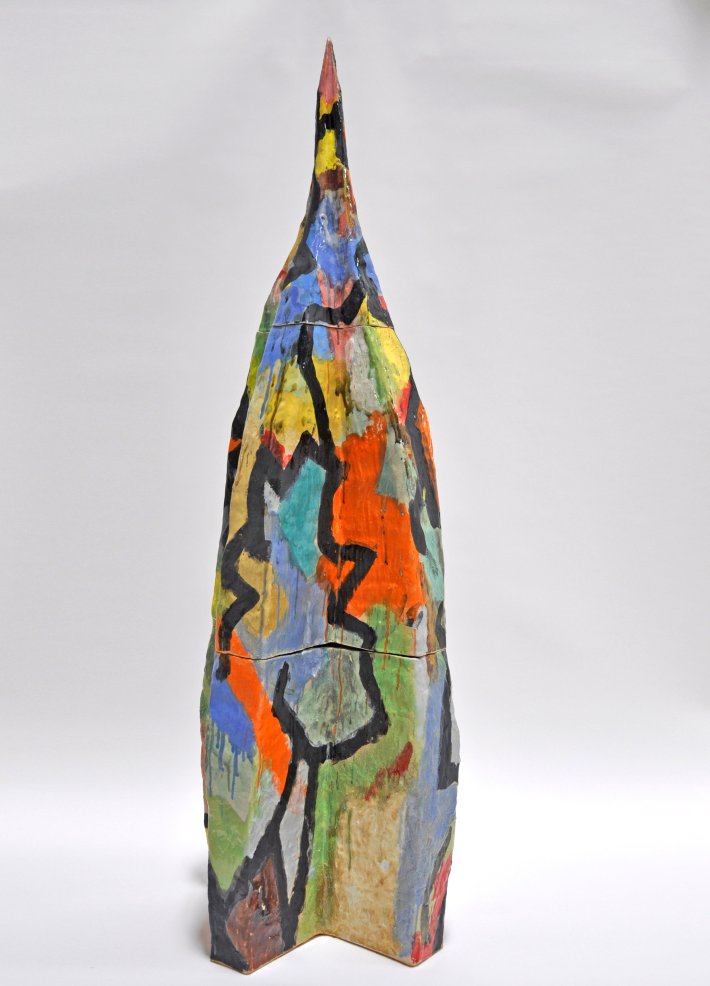
Nick Makanna, XXXIV, glazed ceramic, 69.5 x 25 x 25 inches, 2019.
Many of the structures are topped with a sharp spire or tapered design; others are roofed by a rounded encased belfry, more akin to a steeple. Within these abstracted contrivances, there seems to be a reach for the known, the physical structures of faith or tradition.
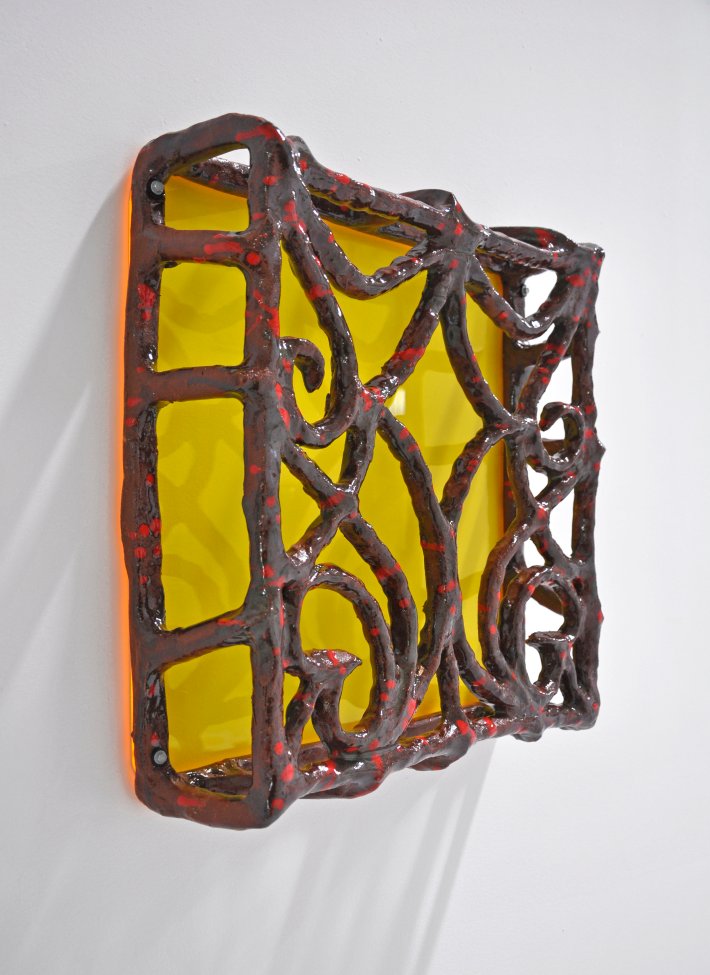
Nick Makanna, Isolationism IV, glazed ceramic and plexiglass, 19.5 x 4.5 x 18.5 inches, 2019.
In his “Isolation” series, Makanna uses plexiglass, which constantly projects a natural illumination, to create windows that he covers with ornamental faux metal (ceramic) grates. Interspersed around the perimeter wall of the show, these glowing casements give the impression of separation — the viewer is inside the gallery, yet outside of some other realm that’s bursting with sunlight. The grates themselves are made to look distressed and signify the lack of trust that urban cities compel. A corresponding ‘us vs. them’ sentiment permeates the scene.
Yousif reminds us that the thread of history weaves past and present, tragedy and comedy, war and play, person to person. The human spirit is resilient if not triumphant, though the tenderness of loss is everywhere apparent. Makanna’s sculpture gives a sense that they are weighty and impervious to harm, even if they are precarious. They speak simultaneously to loss and replenishment.
In the poem by Percy Bysshe Shelley, the shattered remains of a grand statue to an ancient Egyptian “king of kings” lies forgotten in the sand. All that survives of this antique ruler’s arrogant claim to immortality is the hand of the knowing sculptor and the words of the poet. Art, Shelley seems to say, is stronger than tyranny and fear.
By Tamsin Smith & Matt Gonzalez
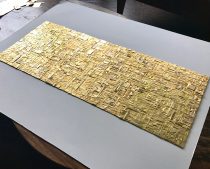


Reblogged this on Tamsin Smith : in Verse.